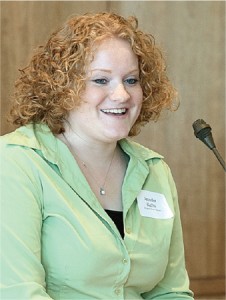NOTE: Jennifer Kellis (’08), a senior majoring in English teaching from Carlisle, Penn., described the ballet technique of spotting as part of her winning essay, printed below, in the 2007 George H. Brimhall Memorial Essay Contest. She and 116 other students researched and wrote about this year’s founder, Karl G. Maeser. Kellis received $1,500, and five others were given awards ranging from $300 to $750 for their essays. Becky Young (’08), a senior majoring in English from Bayfield, Colo., received second place, and Dawn R. Brimhall (’11), a freshman from West Jordan, Utah, was given third place. Honorable mentions were awarded to Lindsay Larson Call (BA ’03), a graduate student majoring in marriage, family, and human development from Orange, Calif.; Moana F. Uluave (’10), a sophomore majoring in English from Salt Lake City; and Jessica Ward (’10), a sophomore majoring in English from Laguna Hills, Calif.
Hard outlines of folding chairs and carpeted gym walls and the image of my mother carefully quilting first blurred then disappeared into swirls of color as my friends and I whirled faster and faster, holding flying skirts down with our hands. Tumbling disoriented to the ground, we’d gasp and hold our heads, waiting for our brains to catch up with our bodies. Every Wednesday, while the small group of faithful Relief Society sisters gathered to carefully stitch beautiful baby blankets, quilts to adorn the nuptial bed, or comforters for those who had lost a loved one, we twirled.
Years later we traded our pubescent awkwardness for womanly grace in dance class, where we learned to twirl elegantly. Oddly enough, of all the deliciously foreign-sounding names such as pirouette and arabesque, the term I remember today is distinctly English—spotting. One of the hazards, some say delights, of a dancer’s career is routines requiring a rapid sequence of spins. Dancers may not engage in the luxury of tumbling dizzily to the ground while they wait for the world to stop spinning. To negate the disorienting effects of twirling, dancers fix their gaze on their target, returning to the same point with each circular rotation of their bodies. This technique is called spotting. By fixing their eyes on an unchanging mark, the dancers can successfully complete one perfect circle or spin across the entire floor and arrive safely at their destination.
Spotting is a crucial life technique, both on and off the dance floor. When plans fall through, doors close, and windows open, we often find ourselves spinning in directionless circles. The key to coming full circle and arriving safely at our destination lies in fixing our eyes on a mark. As a young father, Karl G. Maeser fixed his gaze upon a mark that would change his life. Instead of enjoy a cozy life amidst the intellectual aristocracy of Germany, Karl would find himself impoverished, cut off from his family, but fulfilling his eternal destiny—and shaping the destiny of many others—in a dusty classroom in Provo. Brother Maeser, as he loved to be called, believed deeply in the importance of each student. He knew firsthand some of the complexities and trials that his pupils would shortly face on life’s dance floor. To this end, he constructed a curriculum that enabled each student to gain his or her own testimony of God, Christ, and the divinity of the latter-day work. Students could then shape “all [their] feelings, thoughts, words, and actions in conformity with [their] testimon[ies]” (Alma P. Burton, Karl G. Maeser: Mormon Educator [Salt Lake City: Deseret Book, 1953], p. 72). In effect, Brother Maeser taught his students to spot.
In addition to a personal testimony, Brother Maeser provided other marks to which his students might fix their gaze and complete their eternal circle home. He surrounded his students with exemplary faculty and upperclassmen. He encouraged and dutifully rewarded punctuality, dependability, and respect. His deep conviction in the importance of each student as a child of God shines through his teachings and permeates the university atmosphere today. As the first principal of Brigham Young Academy, Brother Maeser laid the foundation of Latter-day Saint scholastic excellence and raised a generation of spiritually powerful leaders and teachers.
Oddly enough, life has not ceased to spin, nor are we in less need of an anchoring testimony than the students in 1875. For this reason we too enroll in religion classes. Given the opportunity to immerse ourselves each day, or twice a week at the very least, we learn the foundational principles of the gospel and the mark to which we can look to govern our feelings, thoughts, words, and actions. Faculty office doors remain open to students, and relationships of trust are encouraged. Thanks to Brother Maeser, we promise on our honor to obey the university guidelines, to always stand within the circle. Each year bishops around the world conduct ecclesiastical endorsement interviews—echoes of those first interviews that Brother Maeser had with his students. Some would call these safeguards annoying, yet I would call them necessary. When we leave Brigham Young University, we will not spin directionless anymore. We will come full circle home, fixed on the eternal mark, changed forever because an inspired principal cared many years ago.
Sometimes on Tuesday nights, alone in a deserted gym, I close my eyes and remember my mother quilting. One day I will quilt while my little girl spins in circles. I will teach her, as my mother taught me, as Brother Maeser taught his students, where to spot. One day. Smiling, I fix her image in my mind and twirl.










